

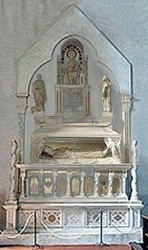
This monument on the left wall is the earliest surviving signed work by Arnolfo di Cambio. It was one of four Cardinals' monuments that were erected in the church in the 13th century: the others were later destroyed and this one has had to be re-assembled from surviving fragments (see below).
Cardinal de Bray died at the court of Pope Martin IV in 1282. His will gave his executors (who included Cardinals Anchier Pantaléon de Troyes and Goffredo d’ Alatri) responsibility for commissioning his monument and selecting its location. They duly commissioned this monument, most probably quite soon after Cardinal de Bray’s death.
Arnolfo di Cambio, who was the leading sculptor of his day, had worked at the court of King Charles d' Anjou in Rome in the period 1277-80. The executors' selection of an artist so close to Charles d’ Anjou is interesting, because Cardinal de Bray had offended the king in 1277 by backing the election of Pope Nicholas III against his wishes. However, the sepulchre once bore the Angevin arms, which suggests a subsequent reconciliation.
The original location of the monument is undocumented, although analysis of the surviving elements suggests that it was in a bay on the right wall, near the counter-facade. It was dismembered (probably not for the first time) when this part of the church was demolished in the remodelling of 1680, and some of its components were damaged or lost. However, it had been reassembled in its current location by the early 20th century (i.e. before the demolition of the nave). Its original composition is also unknown and a matter of debate. However, the surviving parts have been reassembled after a detailed review of all the evidence and the arrangement is as close to the original as current knowledge allows.
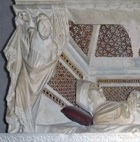
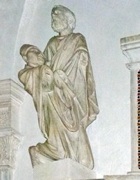
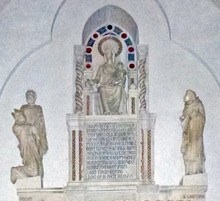
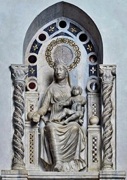
Three sculptural elements stand above the sarcophagus:
-
✴The Madonna and Child are enthroned at the apex of the composition. During the recent restoration, it was discovered that the figure of the Madonna is actually a Roman statue (2nd century AD) with a new hand fitted to hold the figure of the Child.
-
✴St Mark on the left presents the kneeling Cardinal to the Madonna.
-
✴St Dominic stands to the right.
Inscriptions below the figures identify them, and the longer inscription adds that the Cardinal was the titular of San Marco in Rome.
The use of two figures of the deceased on a tomb, one in life and one in death was unusual if not unprecedented and proved to be very influential.
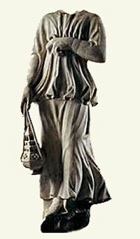
Read more:
M. Coccia and L. Morozzi (Eds),“Arnolfo di Cambio: Il Monumento del Cardinal Guillaume De Bray dopo il Restauro: Atti del Convegno Internazionale (Rome-Orvieto, 9-11 December 2004)” Bollettino d’ Arte, special edition (2009)
Return to Main page.
Continue to Petrucci Tomb and Chapel.
Return to Walk III.

